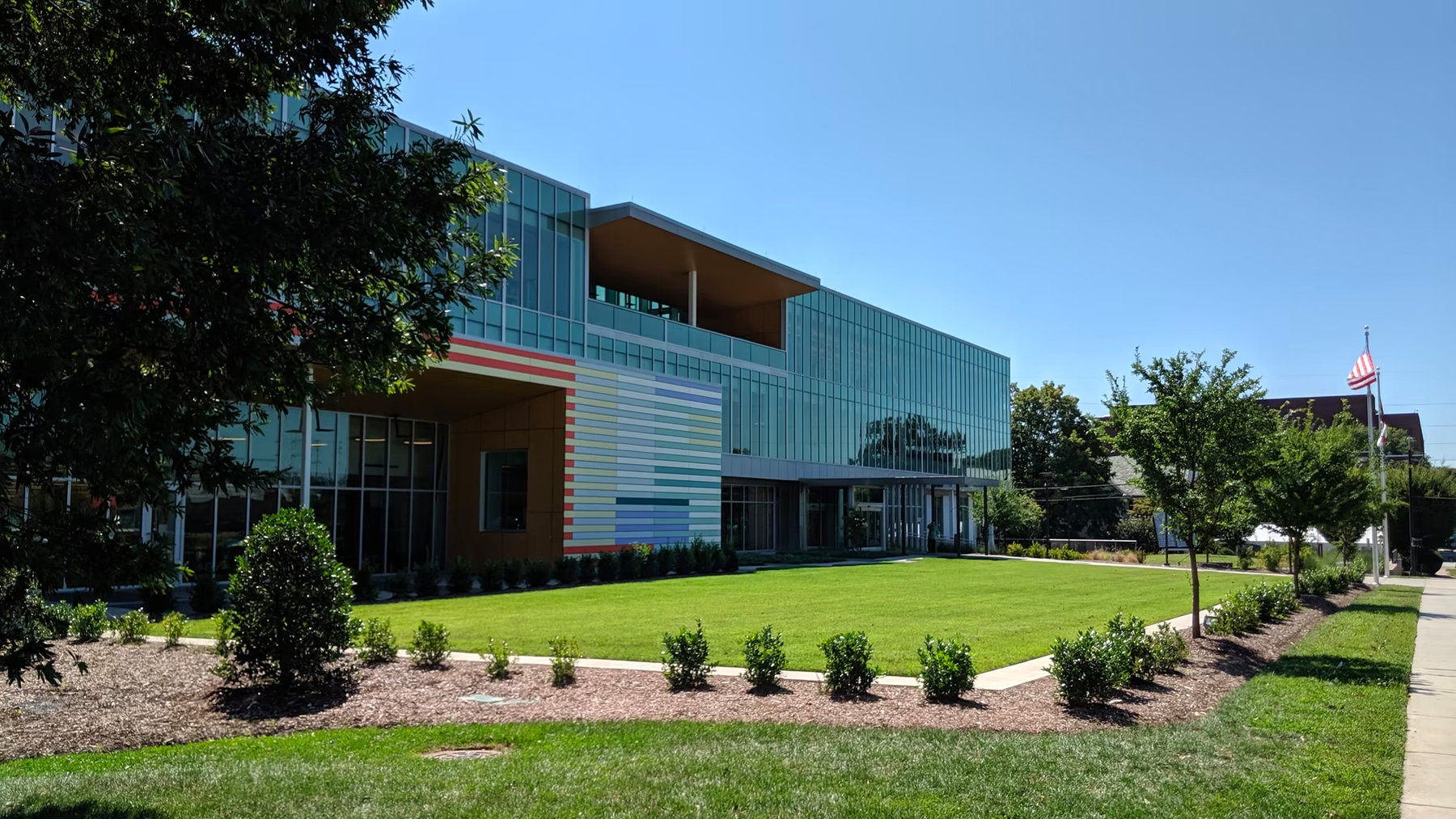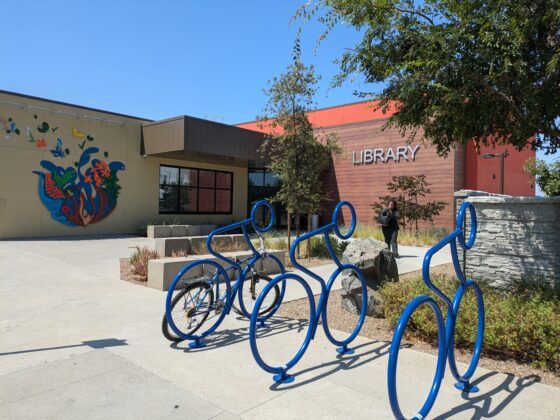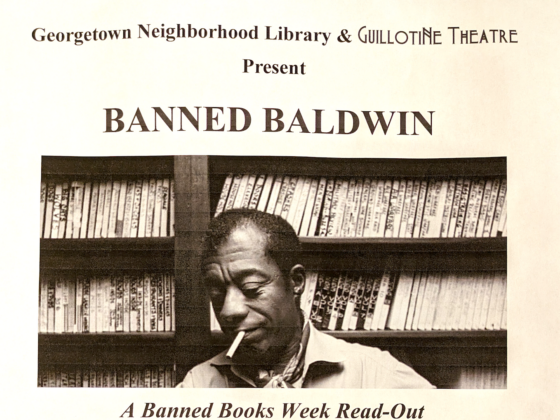She went on to rattle off the wish list of specifics, from meeting spaces, an outdoor place to sit and gather, somewhere to eat, an architecturally significant building, and an art gallery to more seating areas, an atmosphere full of light and spaciousness, and on and on. About a decade earlier, the voters had passed a bond that would provide some $28 million to build the central library, so they were well invested and interested.
The people’s ideas and more have been realized on a grand scale, with spaces to suit all kinds of activities and meetings and gatherings. I peered into the 290-person auditorium during a screening of Thor: Ragnarok, from the popular Avengers series then being run at the library. I walked by the big glass windows of the 10-person conference room, where a full house of young adults, laptops open, was in animated conversation about something—maybe a class, maybe a civic issue, maybe start-up plans. La Rosee said the always discreet librarians “try not to oversee too much” and strive to strike the right balance so that the meetings have a public connection and are not simply for private profit. After all, she reminded me, “the library was built from taxpayer money.”
 Inside the central library of the Forsyth County Public Library (Deborah Fallows)
Inside the central library of the Forsyth County Public Library (Deborah Fallows)There are three smaller rooms with space for up to four people, one with assistive technology for the visually impaired; a sound-production room; and three more rooms tucked in a back corner of the inviting children’s space for private, supervised meetings among, for example, children, parents, and social workers. The library also has a demonstration kitchen and a computer teaching lab.
When I asked La Rosee what the public has to say now that the library has been up and running for two years, she said they report back that all these spaces in the new library contribute to the sense that this is a “hub of Winston-Salem in touch with the people” (her emphasis).
The central library of the Forsyth County Public Library is the main library for the city, but it is also a neighborhood library for a diverse population: those who live in the historic downtown homes, or in factories turned loft space, or in the subsidized housing, or the homeless. Nearly every other library I have visited in the past six years welcomes homeless people who spend their days there. Winston-Salem has addressed its homeless patrons in a creative way. The library was awarded a $150,000 multiyear grant from the state, provided by funds from the Library Services and Technology Act, for staff to learn how to help the homeless with job-readiness strategies and skills, and it hired a permanent peer-support specialist to work with homeless individuals to help them navigate through their often complex set of challenges, from housing and financial assistance to medical services and mental-health counseling.
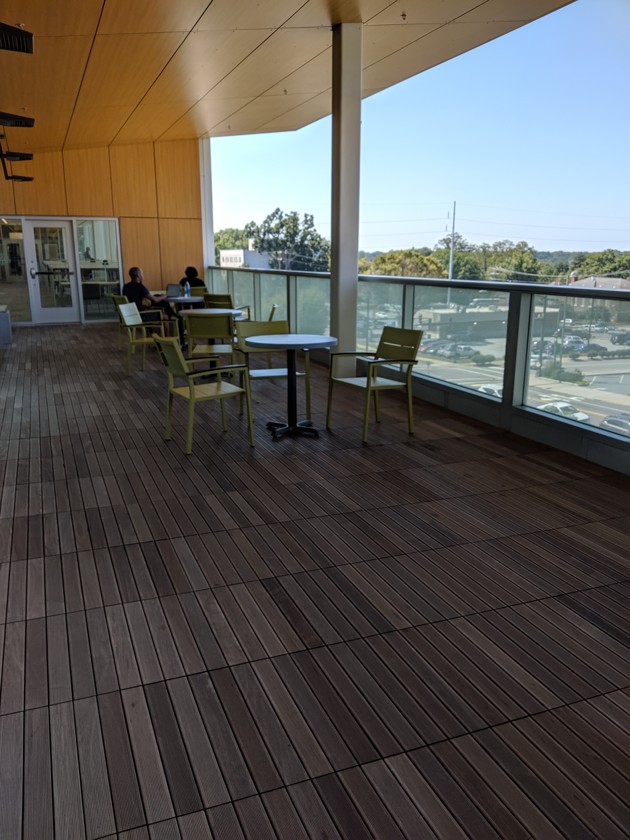 The Wi-Fi–enabled outdoor deck at the library (Deborah Fallows)
The Wi-Fi–enabled outdoor deck at the library (Deborah Fallows)New collaborations have happened courtesy of the new space. Wake Forest Baptist Health’s Sticht Center for Healthy Aging and Alzheimer’s Prevention, which is also a neighbor to the library, found the library a great place to reach out to new populations it could serve. It is in the second year of an ongoing series for the senior members of Winston-Salem on “aging well.” The children from the Downtown School, a nearby pre-K–eight magnet school where many parents who work downtown send them, visit the library regularly. Each elementary class visits the library monthly to learn library and research skills, or to get in-depth information for a class project. Older students come as a group for specific projects they are working on. The library is a natural, convenient, safe, and trusted place for seniors and children to try new things and to spend time. These meetings strengthen the texture and empathy of a community in the same way that YMCAs or public recreation spaces or free arts performances do; they provide the opportunity for town residents to simply be in the presence of others with whom they might not cross paths in their everyday lives.
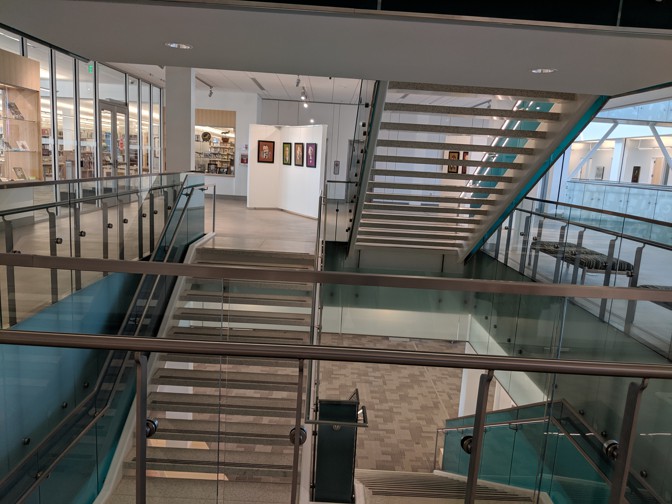 More perspectives from inside the library (Deborah Fallows)
More perspectives from inside the library (Deborah Fallows)When I first walked into the library, I wondered for a moment: Is this an art gallery, or is it a library? The answer is really both. The welcoming open plan, the accommodating wall space, the changing perspectives of the interior you see as you wander from section to section and even floor to floor are a natural invitation to enjoy the library’s permanent collection of art from Ralph Philip Hanes Jr. and many others. Hanes, who was part of a sprawling civic-minded and philanthropic family of Winston-Salem, donated works that include Andrew Wyeth’s Watering Trough. There is much more: a sculpture by Jean René Gauguin, the son of Paul Gauguin, and a very, very large metal sculpture of an open book with the word library engraved in several languages, by the Alabaman Deedee Morrison. The sculpture greets visitors on the front lawn by the main entrance.
 Deedee Morrison’s sculpture Library (Courtesy of Fam Brownlee / Forsyth County Public Library)
Deedee Morrison’s sculpture Library (Courtesy of Fam Brownlee / Forsyth County Public Library)The stewardship of the library’s art struck me as both serious and fun. As for serious, the library cleaned and restored the Hanes collection before placement in its new home. As for fun, on the afternoon that I wandered in, La Rosee was just heading out to pick up more art pieces that people had donated to the library. The way she said it, when she kindly delayed her departure to talk with me, gave me the sense that this particular kind of (pleasant) errand occurred frequently.
Another surprise is the North Carolina Room, described by La Rosee as the “crown jewel” of North Carolina historical and genealogical collections. There is a photograph collection from the region that dates back to the late 19th century; a map collection; the ever popular genealogy section; historical legal information; newspaper archives; travel, culture and folklore holdings; and on and on. You could spend days, months inside this room.
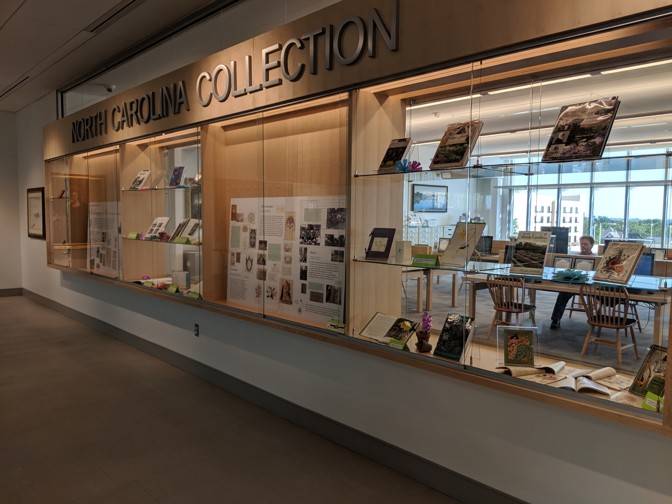 Looking into the North Carolina Room (Deborah Fallows)
Looking into the North Carolina Room (Deborah Fallows)On the technology side, Winston-Salem installed more than five dozen computers for public use, two dozen more used for training new users, seniors, or those seeking to upgrade tech skills for possible new jobs; for Spanish speakers; and with technology for those with disabilities. And looking ahead to the day when more users will bring in their own laptop rather than use the ones at the library (a planning notion that other libraries have mentioned to me as well ), the library has made plenty of room for empty table workspace with plenty of charging stations.
Winston-Salem’s maker space is modest compared with those I’ve seen in many other towns, like Brownsville, Texas, and my hometown of Washington, D.C., which have lots of computer-assisted technologies like 3-D printers and laser cutters. Others have maker spaces like the one I saw in Dodge City, Kansas, which rely on donated equipment like sewing machines and basement-shop tools. The one in Winston-Salem has a modest collection of hardware, 3-D printers, and sewing machines, but La Rosee described it as more of a space for “making and doing” sessions and teaching.
If you’re interested to follow the latest research on how people use libraries, how they value their local libraries, and some of the changing trends in libraries and library use, please go to the Pew Research Center’s collection of surveys and reports. (For the record: I worked at the Pew Research Center’s Internet Project in the early 2000s.)

